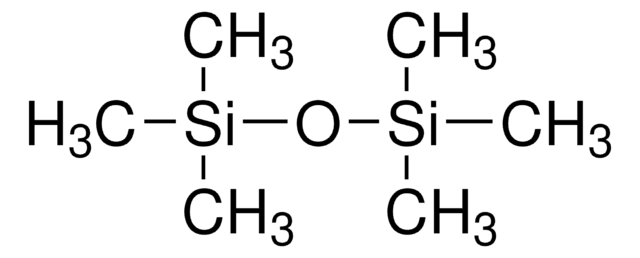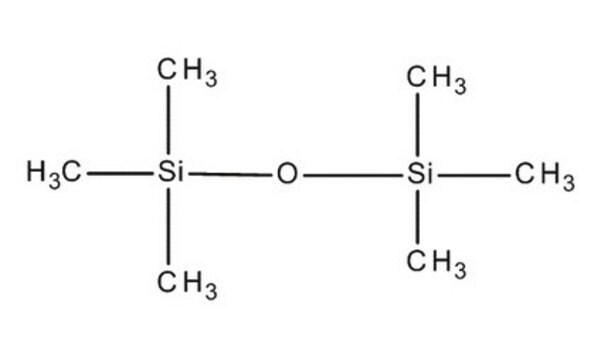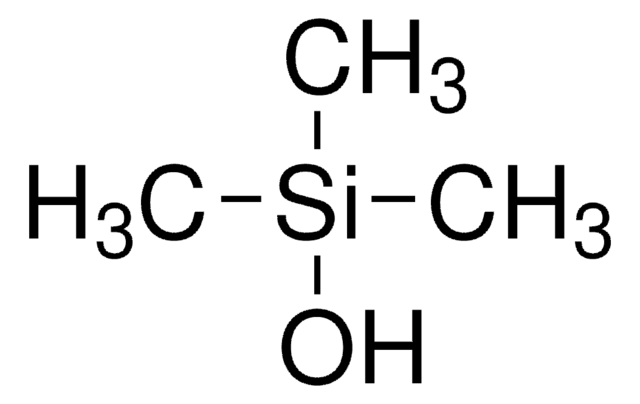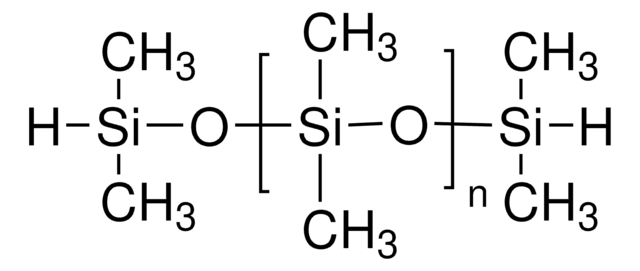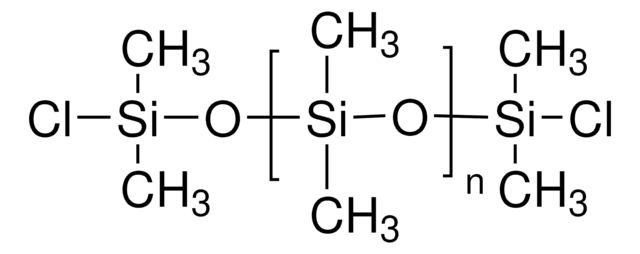469300
Hexamethyldisiloxane
viscosity 0.65 cSt (25 °C)
Synonym(s):
Poly(dimethylsiloxane), HMDSO
Sign Into View Organizational & Contract Pricing
All Photos(1)
About This Item
Linear Formula:
(CH3)3SiOSi(CH3)3
CAS Number:
Molecular Weight:
162.38
Beilstein:
1736258
EC Number:
MDL number:
UNSPSC Code:
12162002
PubChem Substance ID:
NACRES:
NA.23
Recommended Products
vapor density
>1 (vs air)
Quality Level
refractive index
n20/D 1.377 (lit.)
viscosity
0.65 cSt(25 °C)
bp
101 °C (lit.)
mp
−59 °C (lit.)
density
0.764 g/mL at 20 °C (lit.)
SMILES string
C[Si](C)(C)O[Si](C)(C)C
InChI
1S/C6H18OSi2/c1-8(2,3)7-9(4,5)6/h1-6H3
InChI key
UQEAIHBTYFGYIE-UHFFFAOYSA-N
Looking for similar products? Visit Product Comparison Guide
Application
- Superhydrophobic Surface Coating: Studies the application of hexamethyldisiloxane coatings on fabric masks via plasma treatment to achieve superhydrophobic properties, enhancing the masks′ resistance to moisture (M Prado et al., 2022).
- PECVD for Thin Film Coatings: Describes the use of hexamethyldisiloxane in plasma-enhanced chemical vapor deposition to create thin film coatings, exploring the effects of using extremely asymmetric capacitive RF discharge (Ž Gosar et al., 2020).
- QCM-Based VOC Sensors: Hexamethyldisiloxane thin films are used as sensitive coatings for quartz crystal microbalance sensors, enhancing their capability to detect various volatile organic compounds (M Boutamine et al., 2014).
- Hydrophobic-Hydrophilic Films: Explores the polymerization of hexamethyldisiloxane using atmospheric pressure plasma jets to create films with tailored hydrophobic and hydrophilic properties (M Bashir, S Bashir, 2015).
Signal Word
Danger
Hazard Statements
Precautionary Statements
Hazard Classifications
Aquatic Acute 1 - Aquatic Chronic 1 - Flam. Liq. 2
Storage Class Code
3 - Flammable liquids
WGK
WGK 2
Flash Point(F)
21.2 °F - closed cup
Flash Point(C)
-6 °C - closed cup
Personal Protective Equipment
dust mask type N95 (US), Eyeshields, Gloves
Choose from one of the most recent versions:
Already Own This Product?
Find documentation for the products that you have recently purchased in the Document Library.
Customers Also Viewed
Richard Karban et al.
The New phytologist, 204(2), 380-385 (2014-06-13)
Volatile communication between sagebrush (Artemisia tridentata) individuals has been found previously to reduce herbivory and to be more effective between individuals that are genetically identical or related relative to between strangers. The chemical nature of the cues involved in volatile
Edward W Tekwa et al.
Lab on a chip, 15(18), 3723-3729 (2015-08-01)
Localized interactions are predicted to favour the evolution of cooperation amongst individuals within a population. One important factor that can localize interactions is habitat patchiness. We hypothesize that habitats with greater patchiness (greater edge-to-area ratio) can facilitate the maintenance of
Christian A Di Buduo et al.
Blood, 125(14), 2254-2264 (2015-01-13)
We present a programmable bioengineered 3-dimensional silk-based bone marrow niche tissue system that successfully mimics the physiology of human bone marrow environment allowing us to manufacture functional human platelets ex vivo. Using stem/progenitor cells, megakaryocyte function and platelet generation were
T F Holth et al.
Aquatic toxicology (Amsterdam, Netherlands), 154, 240-252 (2014-06-16)
The aim of this study was to characterize concentration- and time-dependent responses in juvenile Atlantic cod (Gadus morhua) following exposure for one and three weeks to the water-soluble fraction (WAF) of three weathered oils: Arabian Light crude oil (ALC), North
Volker F Achterberg et al.
The Journal of investigative dermatology, 134(7), 1862-1872 (2014-03-29)
Changes in the mechanical properties of dermis occur during skin aging or tissue remodeling and affect the activity of resident fibroblasts. With the aim to establish elastic culture substrates that reproduce the variable softness of dermis, we determined Young's elastic
Our team of scientists has experience in all areas of research including Life Science, Material Science, Chemical Synthesis, Chromatography, Analytical and many others.
Contact Technical Service